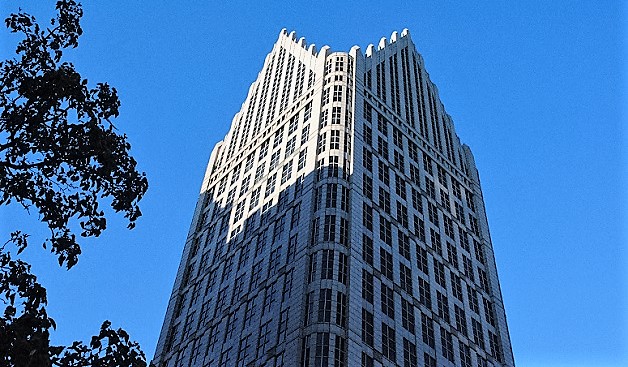
DETROIT—The Metro Detroit office market posted more than 500,000 square feet of positive absorption during the first quarter of 2016, pushing the overall vacancy rate down 90 bps to 18.7%, a rate not seen since 2002, according to a new report from Newmark Grubb Knight Frank.
Companies have continued to demand space in the CBD, pushing the vacancy rate to a record low and spurring investors to refurbish and modernize even more of Detroit's vacant iconic office buildings. And although the suburban office market had struggled for a time, especially in the aftermath of the recession, it also showed great gains last quarter. Office vacancy outside the city fell 50 bps to 19.3%, the lowest in years.
“The consistent level of demand we are seeing from the Detroit CBD to Southfield and Farmington Hills is indicative of the overall health of the office market,” says Frederick Liesveld, managing director of NGKF's Detroit office.
The Farmington Hills office market had one of the best quarters of any submarket. Tenants absorbed 154,000 square feet and drove down vacancy 250 bps to 14.5%. New leases at the Arboretum Office Park at Twelve Mile Rd. and Drake Rd. accounted for much of the progress. Several large-block leases at the five-building, 586,000-square-foot office complex brought its vacancy rate down to 35%, after hovering near 70% for two years. The largest deal was ZF TRW's 171,000-square-foot lease at Arboretum III.
Suburban Southfield's office vacancy rate fell 60 bps to 22.4% as tenants absorbed about 105,000 square feet. “Class A space has begun to trend positive again, as the market for high-end office space posted two straight quarters of positive absorption,” NGKF notes. “Net absorption over the past two quarters for class A space totaled over 157,000 square feet.”
But it is the city's CBD that continues to impress. Although in some ways Detroit seems to epitomize the struggles of many US cities adjusting to deindustrialization, thousands of people, both workers and residents, have moved downtown in recent years. Office vacancy rate fell 270 bps to 15% during the first quarter, as tenants absorbed more than 213,000 square feet.
The iconic 43-story One Detroit Center perhaps provides the best example of the CBD's ongoing transformation. Just five years ago, the building was 60% vacant, but once Ally Financial Inc. moved from the Renaissance Center and into 321,000 square feet, it is now fully leased.
According to NGKF, tenants have absorbed more than 2.4 million square feet of office space since 2011, “leaving the CBD's vacancy rate at levels not seen over the course of 20 years, when the industry began collecting statistics on the office market.” Dan Gilbert of Quicken Loans and other associated companies has led the way. His Bedrock Real Estate Services, for example, is investing $54.6 million to build out the 404,000-square-foot 615 W. Lafayette Blvd. building. Upon completion, Rock Ventures LLC will move 1,100 new Quicken employees into the building.
The future of the Detroit area still looks hopeful. Metro unemployment rate stood at 5.7% in January 2016, down from 7.2% during the previous January. Meanwhile, the region's core industries have continued to grow. Auto companies play a key role in Metro Detroit, supplying manufacturing jobs and a host of office occupations, such as accounting, that support the industry. And after a slight dip in January, US auto sales surged in February. “Many analysts are predicting annual sales to reach a record 17.7 million units in 2016,” NGKF says. “Over the past 20 years, US auto sales have averaged 15.3 million units.”

DETROIT—The Metro Detroit office market posted more than 500,000 square feet of positive absorption during the first quarter of 2016, pushing the overall vacancy rate down 90 bps to 18.7%, a rate not seen since 2002, according to a new report from Newmark Grubb Knight Frank.
Companies have continued to demand space in the CBD, pushing the vacancy rate to a record low and spurring investors to refurbish and modernize even more of Detroit's vacant iconic office buildings. And although the suburban office market had struggled for a time, especially in the aftermath of the recession, it also showed great gains last quarter. Office vacancy outside the city fell 50 bps to 19.3%, the lowest in years.
“The consistent level of demand we are seeing from the Detroit CBD to Southfield and Farmington Hills is indicative of the overall health of the office market,” says Frederick Liesveld, managing director of NGKF's Detroit office.
The Farmington Hills office market had one of the best quarters of any submarket. Tenants absorbed 154,000 square feet and drove down vacancy 250 bps to 14.5%. New leases at the Arboretum Office Park at Twelve Mile Rd. and Drake Rd. accounted for much of the progress. Several large-block leases at the five-building, 586,000-square-foot office complex brought its vacancy rate down to 35%, after hovering near 70% for two years. The largest deal was ZF TRW's 171,000-square-foot lease at Arboretum III.
Suburban Southfield's office vacancy rate fell 60 bps to 22.4% as tenants absorbed about 105,000 square feet. “Class A space has begun to trend positive again, as the market for high-end office space posted two straight quarters of positive absorption,” NGKF notes. “Net absorption over the past two quarters for class A space totaled over 157,000 square feet.”
But it is the city's CBD that continues to impress. Although in some ways Detroit seems to epitomize the struggles of many US cities adjusting to deindustrialization, thousands of people, both workers and residents, have moved downtown in recent years. Office vacancy rate fell 270 bps to 15% during the first quarter, as tenants absorbed more than 213,000 square feet.
The iconic 43-story One Detroit Center perhaps provides the best example of the CBD's ongoing transformation. Just five years ago, the building was 60% vacant, but once
According to NGKF, tenants have absorbed more than 2.4 million square feet of office space since 2011, “leaving the CBD's vacancy rate at levels not seen over the course of 20 years, when the industry began collecting statistics on the office market.” Dan Gilbert of Quicken Loans and other associated companies has led the way. His Bedrock Real Estate Services, for example, is investing $54.6 million to build out the 404,000-square-foot 615 W. Lafayette Blvd. building. Upon completion, Rock Ventures LLC will move 1,100 new Quicken employees into the building.
The future of the Detroit area still looks hopeful. Metro unemployment rate stood at 5.7% in January 2016, down from 7.2% during the previous January. Meanwhile, the region's core industries have continued to grow. Auto companies play a key role in Metro Detroit, supplying manufacturing jobs and a host of office occupations, such as accounting, that support the industry. And after a slight dip in January, US auto sales surged in February. “Many analysts are predicting annual sales to reach a record 17.7 million units in 2016,” NGKF says. “Over the past 20 years, US auto sales have averaged 15.3 million units.”
Want to continue reading?
Become a Free ALM Digital Reader.
Once you are an ALM Digital Member, you’ll receive:
- Breaking commercial real estate news and analysis, on-site and via our newsletters and custom alerts
- Educational webcasts, white papers, and ebooks from industry thought leaders
- Critical coverage of the property casualty insurance and financial advisory markets on our other ALM sites, PropertyCasualty360 and ThinkAdvisor
Already have an account? Sign In Now
*May exclude premium content© 2025 ALM Global, LLC, All Rights Reserved. Request academic re-use from www.copyright.com. All other uses, submit a request to [email protected]. For more information visit Asset & Logo Licensing.








